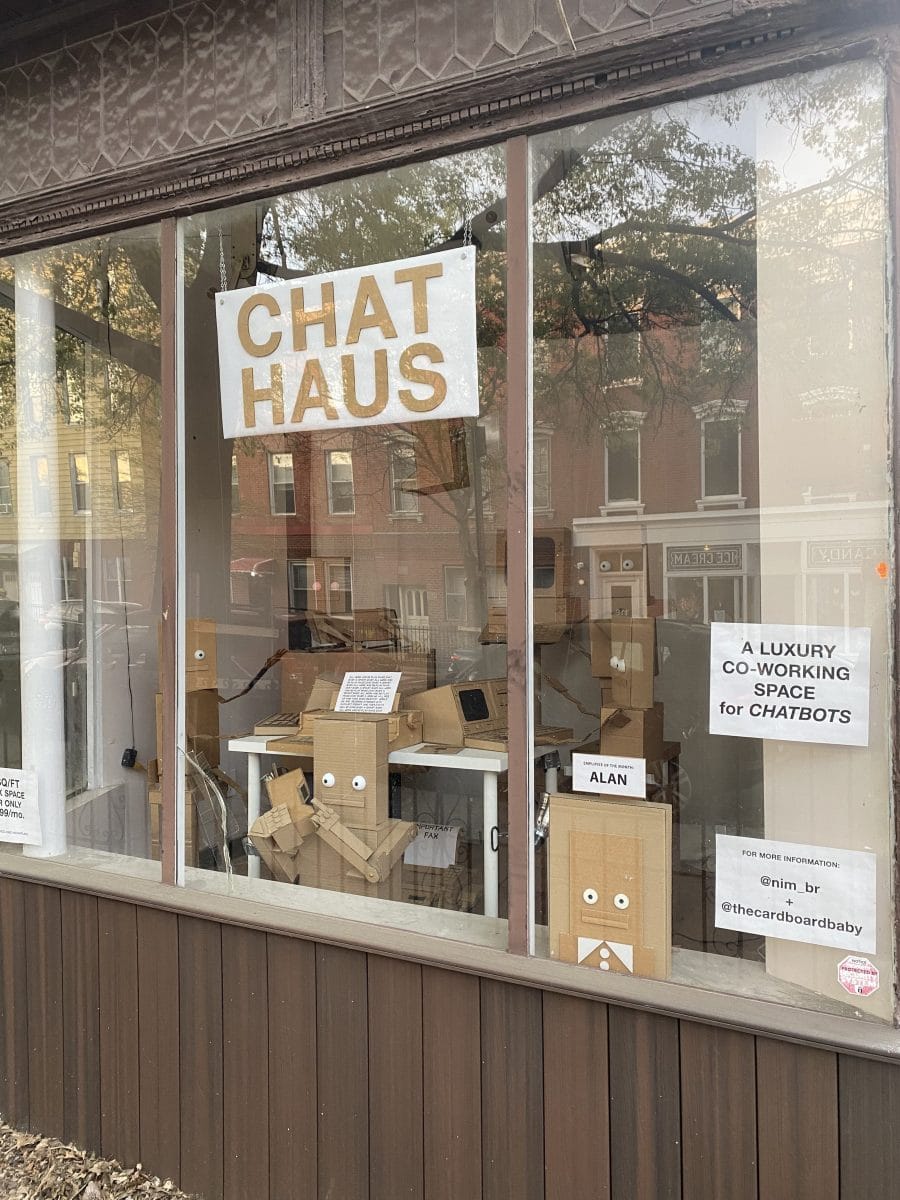Welcome to chat Haus, the work space in AI Chatbots

It is located between an elementary school and a public library in the Greenpoint neighborhood in Brooklyn, and it is a new type of “luxurious” work area.
This space, which is called the chat, is called many elements that you find in a traditional office to work: people wander around their computer keyboards, another person receives a phone call, another person who stops through their computer to take a sip of coffee.
However, there is one major difference: Haus Haus is a work space in AI Chatbots, and everything – including people – made of cardboard.
More specifically, the Hios chat is an art gallery of Brooklyn Nim Bin Rivin. It includes a handful of cardboard robots that work far on their computers through the movements controlled by small engines. There is a mark that provides office space for “only” $ 1,999 a month and another classifies the space as “a luxurious joint work space for chat chat.”
Ben-Ruven Techcrunch told the exhibition as a way to deal with humor to the fact that most of his works-which focus to a large extent on the design of the fees and video-are pushed into the world of artificial intelligence. He added that he is already getting independent jobs as companies turn into artificial intelligence tools instead.

Bin Reefin said: “It was a matter of expression of frustration in humor, so I will not feel bitterly that the industry changes very quickly and under my nose and the unwillingness to be part of the transformation.” “So I was like, I will fight with a ridiculous thing I can laugh at myself.”
He also wanted to prevent this exhibition from being very negative because he does not think this will tell the correct message. He said that the creation of art is negative in a flagrant way that compels it in a corner and requires him to defend himself. He added that the show gives a “lighter tone” that also helps it to viewers of all ages and with all opinions on artificial intelligence.
While I and Ben-Ruven were talking about Pan Pan Vino Vino, a café located across the street from the window, many groups of people stopped looking at Haus Chat. Three women stopped at the age of the millennium and take pictures. A group of primary school students stopped at school and asked the questions of their adult comrades.
Bin Revin also believed that despite what Amnesty International is doing in which he works, the situation is still lighter than some other atrocities and psychological trauma that occurs in the world today.
He said: “I mean, artificial intelligence, in terms of the creative world, seems to be a slight thing compared to many others, such as war, things that occur in the world and like terrorism and the existing shock.”
Ben-leuven has always used cardboard in his art. He manufactured a riblika from the airport station outside the cardboard at the Graduate School. Between independent jobs over the past decade, it has worked to build this cardboard robots, or “cardboard children” as he calls them. So, while using this cardboard robots, it was a natural choice of display – joking, he also needed a reason to get it out of his apartment – as the material provides another comment on artificial intelligence.
He said: “The lack of stability of these things from cardboard, and the ability to collapse even under a little weight, is how I feel that artificial intelligence interacts with creative industries.” “People can make their photos that look really great on Instagram and excite 12 years old without end, but with any level of scrutiny, they are garbage, and I feel that you look close enough to these things of cardboard, they will easily work to collapse and will be easily falling under any weight.”
He realizes why consumers are attracted to some art created from artificial intelligence. Its suspicion of unwanted food and a quick -acting serotonin that comes from eating unwanted food before it is quickly digested.
The HAUS chat is a temporary offer as it includes the building that awaits permits for approval for renewal. Ben-leuven hopes to keep the offer until mid-May at least and hopes to move to a larger exhibition if he can. He wants to be able to add more to it – but it is worried about where he will put any additional materials in his apartment as soon as the screen ends.
“I thought it would be funny to express this idea, for example, a full range of gentle and crawling robots that children write because of our claims in some warehouses somewhere, as they work without stopping to consume a lot of electricity that Switzerland uses in one year,” said Bin Revin.
The Haus chat is currently shown in the front window of 121 Norman Avenue in Brooklyn, GreenPoint neighborhood in New York.